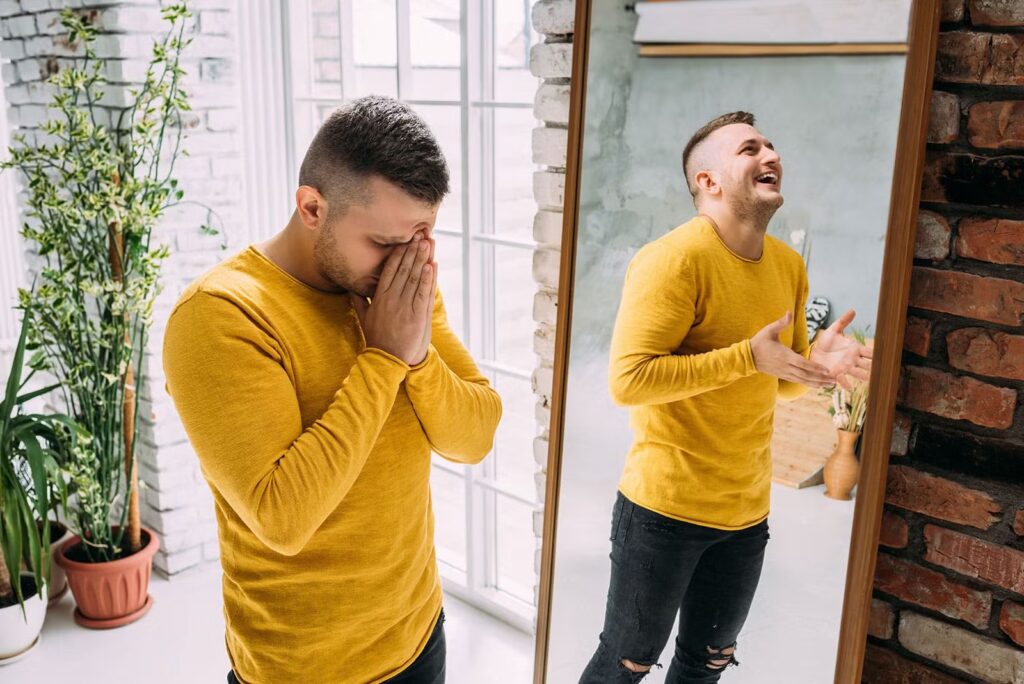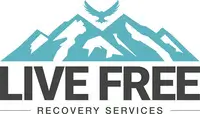Home > Treatment > Dual Diagnosis Treatment > Bipolar Disorder and Addiction
Living with bipolar disorder or struggling with addiction is tough enough on their own, but having both is even harder.
If someone you know receives this dual diagnosis, you’re likely aware of how substance misuse can exacerbate the symptoms of bipolar disorder.
Below, we’ll explore how bipolar disorder and addiction can intersect and impact each other. More importantly, we’ll discuss the treatment options that address both issues at once.
Understanding Bipolar Disorder
Once called manic depression, bipolar disorder is a mental health condition characterized by shifting mood, concentration, energy, and activity levels. You might feel on top of the world one moment, then feel trapped in a deep, dark well the next.

These mood swings—alternating between mania and depression—can go on for hours, days, or even weeks at a time. The symptoms can be severe enough to disrupt daily life, except for hypomania, a milder version of mania.
Hypomanic episodes are shorter and more manageable, with bursts of energy that are less extreme than mania.
If you suspect that your mood swings are out of control, a psychiatrist or any qualified health professional can help you get a diagnosis. The Diagnostic and Statistical Manual of Mental Disorders (DSM-5) provides criteria for diagnosing bipolar and other related disorders.
Risk Factors or Triggers for Bipolar Disorder
Studies suggest that bipolar disorder often runs in families, with a certain gene linked to schizophrenia increasing the risk. Other triggers include:
- Chemical imbalances in the brain
- Stress
- Trauma or abuse
- Alcohol abuse
- Drug abuse
It’s not uncommon for people with bipolar to have co-occurring attention deficit hyperactivity disorder (ADHD). In fact, ADHD usually shows up first. Many also have anxiety disorders.
Common Symptoms of Bipolar Disorder
Bipolar disorder symptoms differ from person to person, but they generally fall into two categories: manic (or hypomanic) and depressive. Many people notice signs before they hit 25; others don’t develop symptoms until later.
Symptoms of manic episodes:
- Feeling unusually upbeat
- Talking too much and too fast
- Having tons of energy, even with little sleep
- Racing thoughts
- Being easily distracted
- Taking on lots of new projects or activities
- Engaging in risky or impulsive behaviors (e.g., excessive spending, gambling, or unsafe sex)
Symptoms of depressive episodes:
- Feeling deeply sad, hopeless, or empty
- Feeling guilty or worthless
- Having little energy and feeling tired all the time
- Sleeping too much or too little
- Eating too much or too little
- Losing interest in activities once enjoyed
- Persistent thoughts of death or suicide
Everyone’s experience with bipolar disorder is unique. Some people may have more manic symptoms, others more depressive ones. The severity and frequency of episodes can also vary.
Types of Bipolar Disorder
There are several types of bipolar disorder:
- Bipolar I Disorder: Manic episodes last at least 7 days, with severe symptoms that may require immediate hospitalization. Depressive episodes occur as well, often lasting at least 2 weeks.
- Bipolar II Disorder: There are bouts of depression and hypomania, but the hypomanic symptoms aren’t as severe as full manic episodes.
- Cyclothymic Disorder: Hypomanic and depressive symptoms can persist for at least 2 years. It’s a less common form of mood disorder, probably because many cases go undiagnosed.
Note: People still experience normal moods, known as euthymia, between periods of highs and lows.
How Bipolar Disorder Can Lead to Substance Abuse
Why people with bipolar disorder often struggle with substance abuse is unclear, but researchers have some ideas. One popular theory is that they turn to alcohol or drug use to self-medicate.
It’s understandable why this can feel like a solution. The sedative or euphoric effects of these substances can take the edge off a mood episode.
Sadly, this is more a diversion than relief—often short-lived and a problem all its own. Because as soon as the “high” wears off, the underlying issues remain, or worse, symptoms can come back even stronger.
These are medical conditions that often feed into each other, creating a vicious cycle where the initial relief leads to intense cravings. Over time, this evolves into addiction, making it even harder to manage a co-occurring bipolar disorder.
In one study, a psychiatric condition like bipolar disorder raises the risk of chronic high-dose opioid use. It was thought that these conditions overlap because they affect the same areas of the brain, particularly the impulse control, motivation, and reward centers.
Another possible reason for this comorbidity is that both conditions share a risk factor: a history of trauma or abuse, whether physical, sexual, or emotional.
The most common substances abused by people with bipolar disorder are:
- Alcohol
- Cannabis
- Cocaine
- Opioids
How Does Addiction Affect Bipolar Disorder Symptoms
Bipolar disorder and addiction can be a dangerous mix. Substances can make symptoms more intense and predictable—like mood swings on steroids. Both conditions can lead to impulsive behavior, and when combined, the risk doubles.
Suicide attempts are also higher when there’s an alcohol use disorder comorbidity. Patients are less likely to stick to treatment, resulting in more hospitalizations.
Additionally, drugs and alcohol can interfere with bipolar medications, either by making them less effective or causing serious interaction. Below are some examples:
- Antipsychotics, a common bipolar drug, increase the risk of opioid overdose.
- Mixing alcohol with second-generation antipsychotics like quetiapine can cause severe drowsiness and incoordination.
- Marijuana can raise lithium (a mood stabilizer) to toxic levels.
How Common Is Bipolar Disorder With Addiction Comorbidity?
Substance use disorder (SUD) is a known trigger for bipolar and other mental health disorders. Patients who didn’t have SUD before diagnosis are at higher risk of developing one later.
Specifically, people with bipolar disorder are about 6 times more likely to develop a substance use problem at some point in their lives. Even when you take other mental illnesses into account, they’re still more than twice as likely to struggle with addiction.
Plus, they are 2–3 times more likely to smoke and have a harder time quitting than the general population. If psychosis is also present, the risk of developing nicotine dependence is even greater.
Treatment Options for Bipolar Disorder and Addiction
Alcohol or drug use is a band-aid solution to bipolar disorder. What you need is a personalized treatment plan that includes a combination of medication and therapies.
Medication-Assisted Treatment
Healthcare professionals often prescribe bipolar disorder medications to treat a comorbid SUD, despite limited research on their effectiveness.
For example, the mood stabilizer Divalproex sodium has shown promise in reducing alcohol use when taken with lithium.
Similarly, the antipsychotic quetiapine has been studied for alcohol use disorder, though results are mixed. Some suggest it can reduce alcohol cravings; others have not shown consistent results.
Still, medication-assisted treatment is generally recommended, especially for opioid and alcohol use disorders.
Therapy
There are three main approaches to psychosocial therapy for co-occurring bipolar disorder and addiction:
- Sequential Treatment: Tackle the more severe condition first, then move on to the other.
- Parallel Treatment: Treat both conditions simultaneously but in separate settings.
- Integrated Treatment: Treat both conditions together using a whole-person approach.
Now, let’s focus on integrated treatment. Because these conditions interact and exacerbate each other, providing simultaneous care while addressing the person’s medical, mental, and social needs can be incredibly helpful.
Below are the most commonly used models in integrated treatment:
1. Cognitive Behavioral Relapse Prevention
Cognitive behavioral therapy (CBT) helps people change negative thought patterns and behaviors. The relapse prevention model is more specialized.
Besides CBT techniques, this model incorporates the following:
- Personalized therapy sessions
- Psychoeducational materials
- Group counseling
- Mutual-help groups (e.g., Alcoholics Anonymous or Dual Recovery Anonymous)
2. Integrated Group Therapy (IGT)
A study published in the American Journal of Psychiatry found that IGT helps reduce substance use in people with bipolar disorder. Patients who participate in IGT are also more likely to stay abstinent from substances and remain free from mood swings.
The main idea behind IGT is that there are many similarities between recovering from and relapsing into either condition. This means the strategies for managing one can often apply to the other.
Thoughts and behaviors are either “recovery” or “relapse.” Focusing the therapy on the shared patterns of thinking and behaviors across both conditions manages bipolar disorder and SUD more effectively.
3. FIRESIDE Model
FIRESIDE is an acronym for these eight principles:
- Follow-up: Emphasize the importance of aftercare.
- Interrelationship of Diagnoses: Address both conditions side by side.
- Relapse Prevention: Focus on strategies to prevent relapse.
- Education: Provide information through lectures, videos, and discussions.
- Stabilization: Use drug therapy aggressively during and after the program.
- Individuation: Tailor the program to individual needs.
- Diagnostic Equivalence: Treat both diagnoses with equal importance.
- Empowerment: Encourage and demand individual responsibility.
Recovery and Self-Care
According to the Substance Abuse and Mental Health Services Administration (SAMHSA), the key areas of holistic recovery and wellness include:
- Taking care of your physical health
- Learning to cope emotionally
- Creating a safe, pleasant living space
- Being financially stable
- Exploring creative talents and expanding knowledge and skillset
- Finding joy and satisfaction in your work or study
- Gaining a deeper sense of purpose and meaning in life
- Developing a support system and a sense of belonging
Final Thoughts
Bipolar disorder and addiction are serious, chronic mental illnesses. Many people battle comorbid bipolar disorder and SUD, without access to treatment or help.
If you’re struggling with terrible mood swings, or if you’ve found yourself relying on substances to cope, we’re here to provide the specialized care and support you need.
References:
- https://psycnet.apa.org/record/2013-14907-000
- https://www.ncbi.nlm.nih.gov/pmc/ articles/PMC5378218
- https://www.nature.com/articles/ s41588-022-01034-x
- https://pubmed.ncbi.nlm.nih.gov/ 29925436
- https://www.cambridge.org/core/ journals/ bjpsych-open/article/psychiatric-risk-factors-for-chronic-highdose-opioid-prescribing-registerbased-cohort-study/ AE2C704B68125BB5616136DA40083D30
- https://www.ncbi.nlm.nih.gov/pmc/ articles/PMC2094705
- https://www.sciencedirect.com/science/ article/abs/pii/S0022395616304782
- https://www.frontiersin.org/journals/psychiatry/ articles/10.3389/fpsyt.2022.1114432/full
- https://psychiatryonline.org/doi/ 10.1176/ajp.2007.164.1.100
Did this article answer your questions?
"*" indicates required fields
Take the First Step Towards a Brighter Tomorrow
At Live Free Recovery, we’re committed to walking alongside you on every step of your journey. Our compassionate team is here to provide the guidance and support you need to overcome addiction and reclaim your life. Don’t wait—reach out today to speak with someone who truly understands your struggles and can help you take that important first step toward healing and a fresh start.
Your path to recovery starts here.
